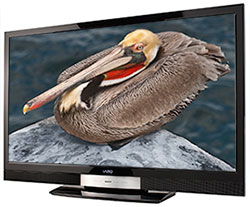
Dick De Jong
August 13, 2009
HDTV Solutions
Last November, I reviewed VIZIO's top of the line model the 42" SV420XVT. They have recently released their next step up the Extreme VIZIO Technology ladder, the SV421XVT and its larger brother, the 47" SV471XVT.
Last year's release, the SV420XVT was a 120Hz LCD. This new SV471XVT boasts a 240Hz SPS display. I don't want to be too technical right now. (I go into more detail later.) Basically, the SV471XVT combines the 120Hz technology with a scanning backlight, which creates a 240Hz effect.
Video theorists may argue about if this method can truly be labeled 240Hz. What I can say is that some of the telltale artifacts that I was noticing during playback of certain movie scenes on the earlier SV420XVT were not visible on the SV471XVT.
If you read my review of the SV420XVT, you will see that those unsightly problems only popped up very rarely. And for the other 99% of the movie, you probably wouldn't be able to discern a difference between the 120Hz and the 240Hz SPS display. But in that one percent, the SV471XVT definitely looked better.
The SV471XVT is truly new and improved.
(Editor's Note: As mentioned, VIZIO makes a 42 and a 47" version of this XVT 1080p LCD line. They have similar specifications and this review of the SV471XVT can be applied to the SV421XVT also. These two models are currently available at Costco and Dell. In addition, the SV421XVT can be found at Sam's Club.)
On the surface, the SV471XVT looks almost the same as the earlier SV470XVT model, with a glossy black bezel and a wide silver swath below. But the 471 does not include a center channel speaker, just the more common left and right front speakers located behind a matte black grille.
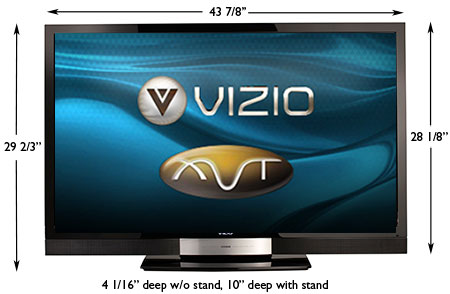
As an indication of the weight reduction occurring in the HDTV industry, this 47" model weighs just over 46 pounds (with its non-swivel stand), which is almost exactly the amount of the 2008 42" SV420XVT.
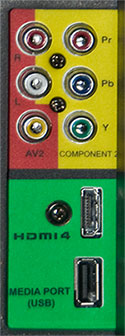
Below the operational controls, on the right side of the SV471XVT is a small convenience connection panel with one HDMI input, one Component video (YPbPr) In and one Composite In. These latter two share a stereo Audio In.
Added to this Summer 2009 model is a USB connection that VIZIO labels the Multi Media Port. You can plug in a USB flash drive and the TV will playback JPEG photos, MP3 music files, and a variety of video formats.
I've missed this feature on previous VIZIOs and I'm glad to see it here, especially since the designers did such an admirable job with the handsome interface.
In the slideshow section, you can select photo durations in one second intervals from 5 to 32 seconds.
Eight different transitions are furnished including Wipes and Boxes. You can even add music without leaving the slideshow menu.
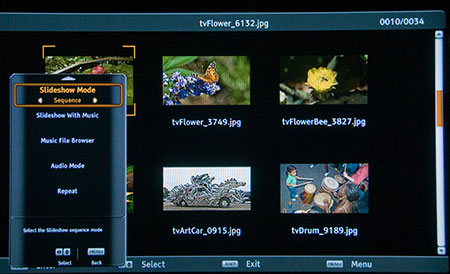
I would prefer the ability to adjust the picture while in the Multi Media Port menu. Also, the USB connection is in tight quarters. If you have an oversized USB drive, you will have a difficult time inserting it into the port. VIZIO suggests using a USB extension cable.
On the back of the TV, all of the other connections are facing out and easy to access. (Thank you, VIZIO.) On this panel are three more HDMIs with one matching stereo Audio In, one more Component with Audio In, one more Composite with an Audio In, an S-Video, one VGA PC input with an Audio In (stereo minijack), one stereo analog Audio Out and one digital Audio Out.
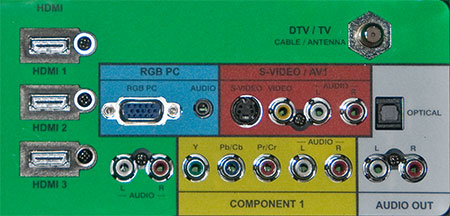
The one RF antenna connector links to integrated ATSC/QAM tuners. Since the tuner system is Clear QAM compatible, you can attach your cable TV signal directly into the RF connector and tune in unscrambled cable stations.
For those concerned about the DTV transition, the ATSC tuner is the key. With the proper antenna, you will be able to tune in digital signals broadcast over the air.
If you want Internet connectivity, the SV471XVT does not provide it. You will have to wait until October before the first VIZIO is released with integrated Internet apps.

VIZIO does offer both Picture-in-Picture and Picture-outside-Picture capabilities with controls for sizing and positioning insets. You are limited in the combinations of sources. For example, you cannot PIP two HDMI sources.
When you punch any of the buttons on the elegant, spacious silver and black remote the keys light up. I would prefer dedicated buttons for different inputs, though I realize that would start to crowd the layout.
The manual is big, easy-to-read, and well illustrated. Overall, it is informative though some features are given minimal coverage and others like Real Cinema are not mentioned at all.
The EPA is now publishing a list of ENERGY STAR qualified TVs. (You can find it here.) At this moment the SV471XVT is not on the list. VIZIO states that this 47" LCD, which they label an ECO HD, exceeds by 15% the current minimum ENERGY STAR standards. I assume we will see it on the list soon.

In the manual, VIZIO states the Average On Mode Power is 253W and Standby Power Consumption is 1.0W. (I've been informed that VIZIO uses the Vivid/Retail mode reading for this number. The Home/Standard power rating is the one used in the Energy Star list and it is 176W On and 0.36W Standby.)
We decided to run our unofficial test and quickly reconfirmed what we have said many times, power consumption will vary depending on the Picture Mode and settings that you choose. For example, Vivid picture mode at its defaults ran about 257W.
Standard fluctuated between 200 and 227W. Movie dropped down to the 145 to 160W range. My Custom settings, which included adjusting the Backlight to 20, consumed about 105W.
For its part, the EPA requires that in the initial setup of an Energy Star HDTV, you must choose Home Mode or Retail Mode. Retail sets the Picture Mode to Vivid and Home puts it to Standard. If you pick Retail, a warning appears.

To calibrate the TV, we use two discs, the Blu-ray version of the Digital Video Essentials DVD called HD Basics and the Spears & Munsil High Definition Benchmark Blu-ray DVD. We are playing the DVDs on the OPPO BDP-83 Blu-ray player connected to the HDTV with an HDMI cable.
We use the test patterns to adjust black level, white level, and color bias. The player is set to output a 1080p signal, which is the native resolution of the SV471XVT.
Before I start spinning the calibration discs, I sample the Picture Modes provided by VIZIO. And there are a lot of them: Vivid, Standard, Movie, Game, Football, Golf, Basketball, Baseball and Custom.
I suggest that you scan through them. Who knows, maybe you will find one that meets your taste and you can skip this whole setup rigamarole. I also usually recommend that you take a hard look at Movie because it's often closest to what the technicians at the manufacturers consider correct. But Movie mode on this VIZIO seemed a little too vibrant for me. Give it a try anyway.
I chose Custom and turned down the Backlight to 20 (on a scale of 100). I don't normally drop the Backlight that low, but this TV kept egging me on. And the room here is light controlled and as you see, reducing the Backlight saves electricity.
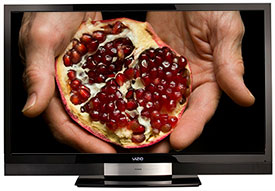
Next, I set the Color Temperature, which is located in the Advanced Video sub-menu. The four options are Normal, Custom, Cool or Computer (the 9300K setting). Notice that there is no Warm, but you can tweak any of the defaults with the individual Red, Green and Blue controls. I chose Normal and left the R, G, and B sliders untouched.
While in the Advanced Video menu, I tend to turn off almost all the features like Color Enhancement and Advanced Adaptive Luma. When I'm finished with the basic adjustments, I will return and experiment with these.
Then I work through the test patterns. I punched up Brightness to 54. I dropped Contrast to 39, which is lower than usual. Also Color (Saturation) ended up at 39. Tint (Hue) was unchanged. The range for Sharpness is 0 to 7. Anything above 4 causes unsightly fringing.
Once I dropped the Backlight down, the basic adjustments produced a wonderfully sharp, rich image. And if I engaged the Smooth Motion and Real Cinema features often the picture looked almost three dimensional.
I've talked in technical detail about Smooth Motion and Real Cinema before in my review of the SV420XVT. I don't wish to repeat myself, but I do suggest that you read that discussion here.
Let me discuss the new twist with the SV471XVT. VIZIO labels it 240 SPS (scenes per second). If you have been following the advances in display technology, TV makers have upped the frame rate on LCDs (plasmas work differently).
Traditionally, TVs displayed 60 frames per second, or 60Hz. In the last couple of years, 120Hz TVs have become the new must-have tech. To generate the additional frames, an in-between frame is created by interpolating the motion from the original frames by a technique called Motion Estimation/Motion Compensation (MEMC).
(The concepts for these diagrams are courtesy of Calvin Lee, a Junior Engineer at VIZIO.)
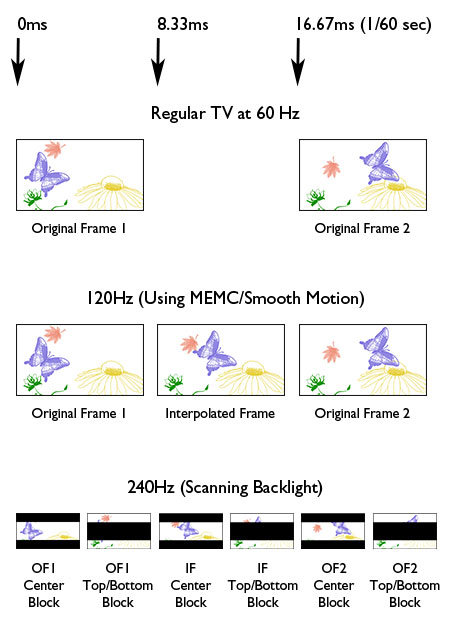
This is exactly what the SV471XVT does, but they then take it a step further. They duplicate each one of the 120 frames and display them with a scanning backlight that shows half the picture at every "scene." The key to understanding scanning is that this LCD has a series of backlights illuminating the display and they can be turned off and on individually.
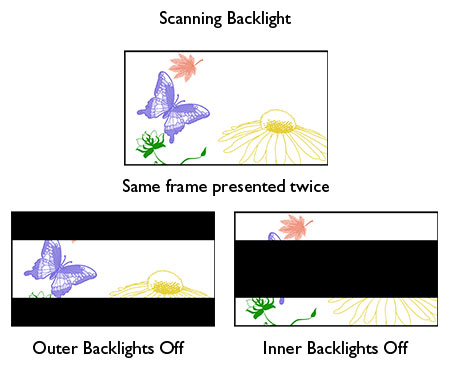
While some manufacturers have decided to create the 240 frames solely with MEMC, VIZIO among others have opted for this scanning backlight method because they believe that it causes fewer artifacts, less smearing and requires less power.
I think for many of us, the technology is racing beyond what our human eye can perceive. And right now, you will pay a premium for any of the 240Hz TVs. Though I assume that gap will narrow soon. Of course, by then, we will probably see 480Hz models hit the market.
What I was able to clearly see was the improvement in the halo artifacting that I noticed with the SV420XVT. For example, in one scene in the Pride and Prejudice HD DVD, Miss Elizabeth quickly walks away from Mr. Darcy and descends a staircase with leafy bushes in the background.
With the SV420XVT, she stays sharp, but a halo or bubble forms around Elizabeth. With the SV471XVT, there is no halo - no artifacts. I've been informed by a VIZIO engineer that they have improved the MEMC algorithms and I say "Bravo."
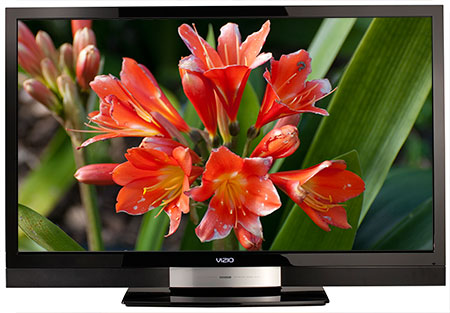
Not only do the new calculations raise the picture quality, it also takes the guesswork out of setting the Smooth Motion and Real Cinema controls. Basically, you should be fine with Smooth Motion at Medium and Real Cinema at Smooth.
The main reason to fiddle with them at all is if you feel that the sharp, video-like appearance is disconcerting when watching movies. If you are a traditionalist, try turning off Real Cinema and Smooth Motion.
When manufacturers throw new technology at you, it becomes easy to be distracted from what's really important, performance. And the SV471XVT has raised its game a notch or two over the earlier 420. Probably most noticeably in consistency.
When you are pushing the edges trying to squeeze out performance, you run the risk of inducing unwanted artifacts. The SV471XVT has overcome that problem.
Now before I become too bubbly with praise, I felt that out of the box, the programmers were too frisky in calibrating this TV. I kept wanting to tone it down, finally to the extent of dropping the Backlight to 20.
For many of you, that might be way too subdued and I will give VIZIO credit for the amount of latitude they afford you when setting up the picture.
I still don't believe that this LCD TV has the same inherent deep black levels that I admire in better plasmas - including the soon to be discontinued ones from VIZIO. The SV471XVT does provide tools like Advanced Adaptive Luma and Backlight Control to reign in Brightness and improve Black Levels. I prefer to go au naturel. But you should try them on and see if they appeal to you.
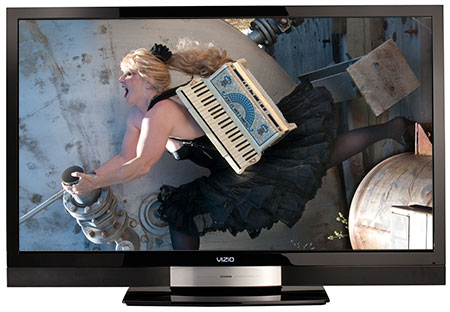
As for audio, even with SRS TruSurround HD processing available, those internal pair of 15W speakers will never be confused with a dedicated A/V system. And the sonic output really doesn't do justice to the superior picture quality.
The 240 SPS VIZIO SV471XVT improves on its 120Hz predecessor. Though both can generate a startling 3D-like image, this new model achieves an artifact free consistency.
Posted Jan 19, 2010 11:45:09 PM
By GantryG